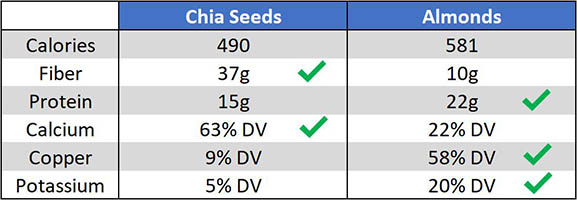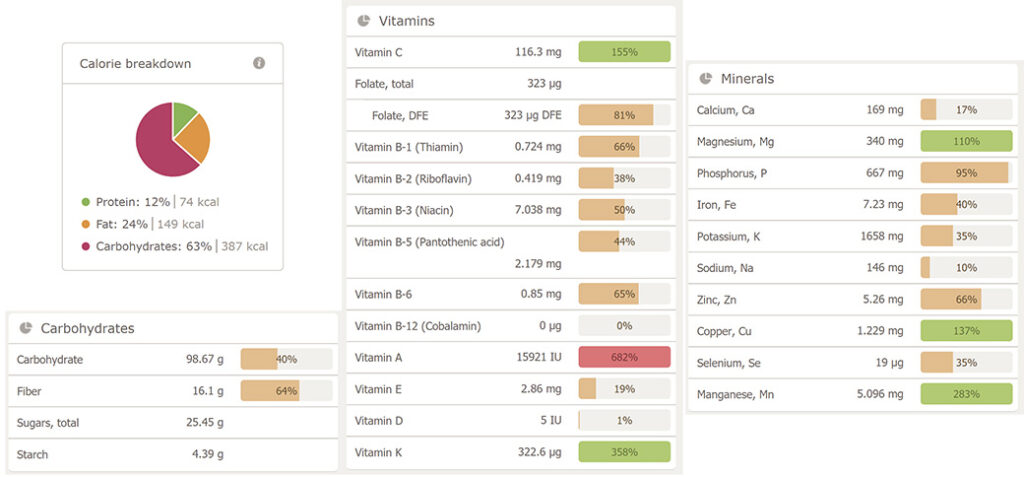Watermelon seeds, acai berries, pine nuts, seaweed, maca powder and black garlic. These are just a few superfoods that have hit headlines within the past few years. Foods that are extremely nutrient dense. Exotic foods found around the world. Foods that have the ability to fight cancer, prevent heart disease, melt fat, increase energy levels and make you feel super. And if these superfoods are new to you, seem exotic, and have tons of health benefits, you’re probably eager to learn more. Because we’re always looking for a shortcut, a “get rich quick” strategy, a new method to achieve quicker and better results. But, are superfoods really that super?
Analysis
Let’s look at a couple examples. Chia seeds have been called a superfood because of their extremely high concentration of calcium. 100 grams of chia seeds provide 63% of your recommended daily value. That’s a lot. And, when I researched other high calcium foods, the closest plant I could find were almonds with a 22% daily value per 100 grams. So, if chia seeds provide three times the value of calcium than the next highest rated food, then chia seeds really are a super food. Right? Well, let’s stop looking at this from a microscopic view and take a small step back. Here’s a quick comparison chart for these two foods.

And, what you find is that chia seeds do have a lot of calcium, fiber, and protein. But almonds provide more protein, and a lot more copper and potassium. And these are just 5 different components I selected for the purpose of this example. The truth is foods are made up six major nutrients (Carbohydrates, Lipids, Proteins, Vitamins, Minerals, Water) and these major nutrients can be broken down into dozens of different components. Therefore, it’s almost impossible to look at them and decide which is better than the other using one component alone like calcium. Even if you’re concerned about your calcium intake, nearly all plants contain calcium. So if you’re eating a plant-based diet, you’re likely eating enough calcium too.
Let’s go into one more example. Guavas provide the highest concentration of Vitamin C of any food. Second behind that are bell peppers (according to My Food Data). Guavas provide 381% of your daily value in Vitamin C and bell peppers provide 213%. Guavas provide almost double the amount. Superfood then, right? Let’s check.

Again, even though guavas have been labeled a superfood because of their Vitamin C content, we can see bell peppers are also high in Vitamin C while also providing lots of Vitamin A. And again, I’m just selecting a few nutrient components out of the dozens that make up a food. If we zoomed out even more from our microscope, and saw the food as a whole rather than a few key components, we’d see that both of these foods are equally impressive in their own respect.
The point is, each food, “superfood” or not, provides a different set of benefits than another food. Some foods may have a high concentration of one nutrient while other foods may be more well rounded. But, no food is really “better” than another food. And if you’re looking to have a super diet, that’s nutrient dense, provides you with energy and disease fighting nutrients, I’m going to tell you just how to do that. And, it’s simpler than you think. It’s not about finding exotic, unique, new foods. It’s about eating a variety of organic plants. It’s that simple.
Plants are Super
Research has shown that only a whole foods plant-based diet can not only prevent or manage heart disease, but in some cases reverse it. Because plants are so nutrient dense, you consume a ton of valuable nutrients in a short period of time when on a plant-based diet. These high density nutrients help prevent most cancer, heart disease and stroke. It can even help with depression, anxiety and energy levels. And, plants have nearly zero side effects from consumption and no long term consequences. So if you’re looking for a super food, choose any plant!
- Vegetables: Leafy greens, carrots, tomatoes, peppers, onions, garlic, mushrooms…
- Fruits: apples, oranges, bananas, kiwi, blueberries, raspberries, grapes…
- Whole Grains: quinoa, oats, rice, millet, barley, spelt, rye…
- Nuts/Seeds: almonds, cashews, walnuts, pistachios, brazil nuts, pecans…
- Legumes: lentils, peas, black beans, kidney beans, chickpeas, peanuts…
Variety is Super
If you’re eating a plant-based diet, my next recommendation is variety. As shown above in the analysis section, some foods provide specific nutrients but lack others. So the best way to achieve all the benefits your body needs, for the dozens of nutrient components, is to eat a wide variety of plants. To do this, I recommend eating foods from each of the categories listed above (vegetables, fruits, etc.) and then eating a variety of foods within those categories. A good way to do this is to try eating different colors within each category. For fruits, I may choose bananas (yellow), strawberries (red), and grapes (green or purple). For vegetables, maybe spinach (green), garlic (white), and carrots (orange). A lot of times, it’s the nutrient complex that gives the food its color. So if you’re eating a variety of color, you’re eating a variety of nutrients. This method allows you to take a “superfood” and make a “supermeal.” And we all want a supermeal.
Supermeal Salad:
- Vegetables: spinach (green), carrots (orange), mushrooms (brown)
- Fruits: blueberries (blue), strawberries (red), pineapple (yellow)
- Whole Grains: purple rice (purple)
- Nuts/Seeds: chopped cashews (tan), pumpkin seeds (green)
- Legumes: black beans (black)
Supermeal Nutrition Facts:

From the nutrition facts above, we can see a meal that’s extremely nutrient dense. It has tons of Vitamin A, B, C and K. It’s also rich is magnesium, phosphorus, iron, zinc, copper and manganese. And you won’t find one super food that’s as healthy as this super meal. As I said, variety is super.
Organic is Super
Lastly, I recommend buying organic food for one main reason. No pesticides. With conventional farming, pesticides are used to kill or deter insects from destroying crops. These pesticides are generally sprayed on plants. When the plants grow, these pesticides not only stay on the plant, but get consumed inside it. So, when you end up eating a non-organic plant, even if you’ve washed it, you’re still consuming these pesticides. And while there are limits on pesticide use, and the amount you consume is an extremely small amount, these small amounts of pesticide consumed over a long period of time (decades) can cause many issues.
Final Thoughts
Watermelon seeds, acai berries, pine nuts, seaweed, maca powder and black garlic. They’re just as super as bananas, apples, spinach, peppers and onion. What’s super are plants. A variety of plants. A variety of organic plants. So, let’s not focus on how super one food may be, and focus on how super our entire meals can be.
If you liked this post, please subscribe to the weekly newsletter and follow the social media accounts for the latest content!
Related Reads: I Don’t Trust the Food Pyramid or MyPlate and CBD, Impossible Burgers and The Keto Diet

Hey, I am Brandon Zerbe
Welcome to myHealthSciences! My goal has always been to increase quality-of-life with healthy habits that are sustainable, efficient and effective. I do this by covering topics like Cognitive Health, Fitness, Nutrition, Sleep, Financial Independence and Minimalism. You can read more about me here.
Sources:
- The Department of Health
- My Food Data
- SELF Nutrition Data
- Physicians Committee for Responsible Medicine
- Happy Forks
- WebMD
Disclosure: I frequently review or recommend products and services that I own and use. If you buy these products or services using the links on this site, I receive a small referral commission. This doesn’t impact my review or recommendation.
